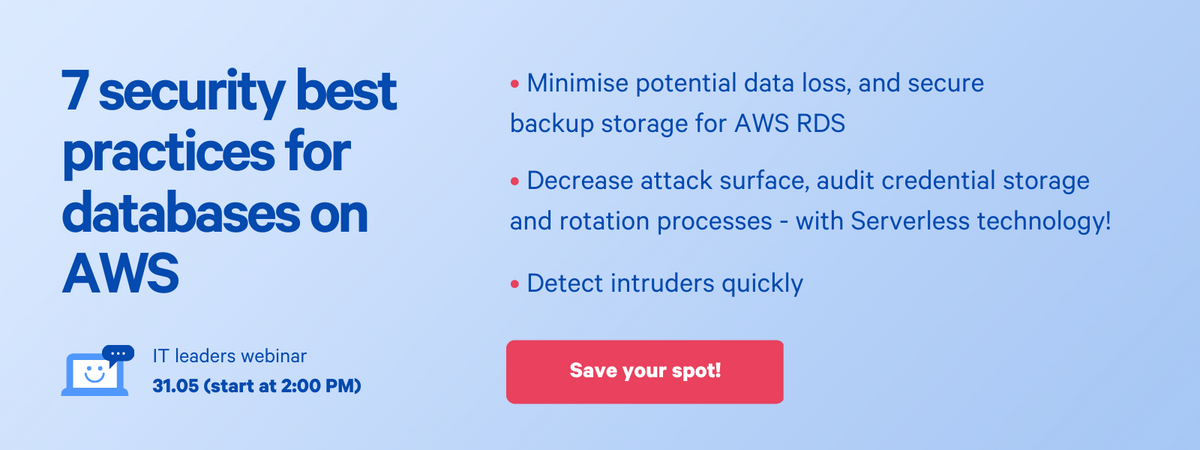🛡️ 5 Strategies to Improve
Database Security on AWS
Safeguarding company data and maintaining a reliable infrastructure are key responsibilities for IT managers. This article presents five strategies to enhance AWS database security, from secrets rotation to adopting serverless computing. Let’s dive into fortifying your AWS database security!
TL;DR 📝
- Fundamentals first: encryption, access control, backup, logging & monitoring
- Secure credentials with Secrets Manager
- Adopt serverless computing for reduced vulnerabilities
- Detect leaks using honeypots
- Attend AWS RDS security webinar for more insights
📚 Start with the Fundamentals – Encryption, Access Control, Backup, Logging & Monitoring
Though not unusual, the essentials—encryption, access control, backups, logging, and monitoring—are often overlooked. Use robust encryption algorithms like AES-256 for data encryption at rest or in transit. Implement proper access controls to ensure only authorized users access the data. Conduct regular backups to protect your data in case of system failures or breaches. Lastly, employ logging and monitoring to detect any suspicious activity within your environment and take swift action when needed.
🗝️Secure RDS Credentials with Secrets Manager
Securing your database credentials using a secrets manager, such as AWS Secrets Manager or similar alternatives, is highly effective. This tool securely stores and manages your application credentials, preventing the need to hard code them into your code. Instead, store the credentials as secrets and securely access them through AWS. This way, if a resource is compromised, the rest of your data remains safe. You may want to read our CTO’s article, “An Introduction to Secrets Rotation.“
☁️ Embrace Serverless Computing for Simplified Vulnerability Management
One of the key benefits of serverless computing is that it eliminates the need for infrastructure maintenance. By shifting the responsibility of managing servers and their associated vulnerabilities to the cloud provider, you can focus on writing code and implementing application-level security measures. This approach reduces the attack surface and minimizes potential vulnerabilities that may arise from server misconfigurations or outdated software. As a result, serverless computing enables you to maintain a secure and robust environment while enjoying the benefits of simplified infrastructure management.
👀 Monitor for Credential Leaks Using Honeypots
One effective method to detect leaks is through the use of honeypots. Honeypots are decoy systems or resources designed to attract attackers and gather information about their methods and techniques. By setting up honeypots with fake credentials, you can monitor for unauthorized access attempts and gain valuable insights into potential vulnerabilities in your system. This approach enables you to identify and mitigate security threats proactively, ensuring your actual credentials and sensitive data remain well-protected.
📢 Join Our Webinar to Learn More
Don’t miss our upcoming webinar on AWS RDS database security best practices! Gain insights from our expert speakers on critical topics, including encryption, access controls, credential rotation, backups, and monitoring. Discover practical tips for enhancing your database security posture. This informative and engaging session is perfect for AWS RDS newcomers and seasoned pros alike. Register now to secure your spot!

Conclusion
Enhancing your AWS database security necessitates a multifaceted approach that combines Amazon’s built-in security features with your own robust policies. Establishing a strong foundation for security through encryption, access control, backups, logging, and monitoring is vital. Moreover, leveraging tools like secrets managers and serverless computing can further improve database security. Lastly, consistently monitoring potential credential leaks and unauthorized access enables swift mitigation of security threats.